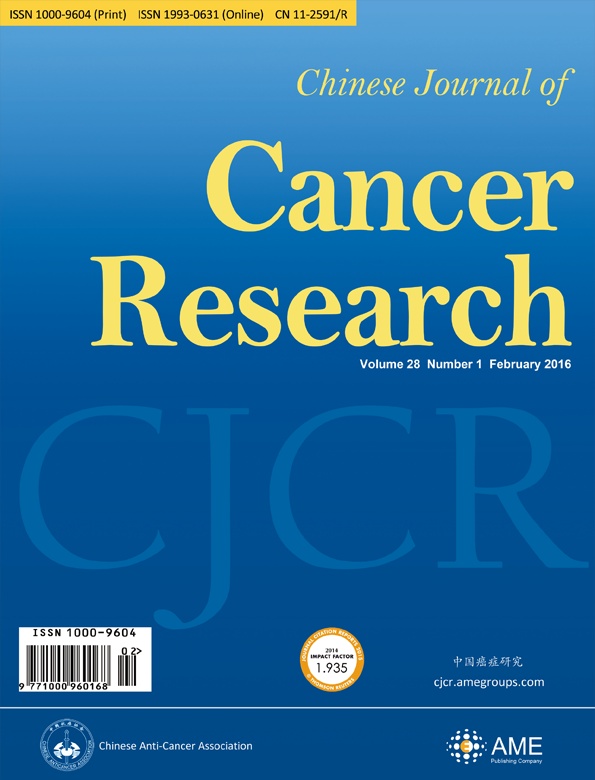突变型p53增加外泌体介导的miR-21-3p和miR-769-3p的转移以促进肺转移
IF 7
2区 医学
Q1 ONCOLOGY
引用次数: 23
摘要
目的肿瘤转移是一个复杂、多步骤的过程,取决于肿瘤细胞及其与肿瘤微环境的沟通。p53功能获得突变体已被证明能增强肿瘤细胞的肿瘤发生、侵袭和转移能力。本研究旨在探讨p53 R273H突变在肿瘤微环境中的作用。方法研究p53 R273H突变体对HCT116细胞侵袭转移的体内外影响。将来自野生型和HCT116-TP53(R273H)细胞的外泌体与小鼠胚胎成纤维细胞(MEFs)共培养。研究了通过微阵列分析鉴定的差异表达的外泌体微小RNA的作用。还通过基因表达微阵列和定量聚合酶链式反应(qPCR)分析研究了p53 R273H突变体在肿瘤细胞中的功能。结果将突变型p53 R273H导入HCT116细胞,可显著增强肺转移。在来源于HCT116-TP53(R273H)细胞的外泌体存在的情况下,外泌体被MEFs吸收并被激活。微阵列分析显示,p53 R273H突变增加了miR-21-3p和miR-769-3p的外泌体水平。有趣的是,在临床样本中,具有p53突变的患者的miR-21-3p和miR-769-3p水平显著高于没有该突变的患者。此外,miR-21-3p和miR-769-3p都激活了成纤维细胞,并通过其靶基因对转化生长因子-β(TGF-β)/Smad信号通路发挥协同作用。活化的成纤维细胞分泌细胞因子TGF-β,并可能相互诱导癌症细胞进行上皮-间质转化(EMT)。事实上,HCT116-TP53(R273H)细胞显示ZEB1和SNAI2的表达增加,并且几种细胞粘附分子的转录减少。结论突变的p53外泌体miR-21-3p/miR-769-3p-成纤维细胞因子回路似乎负责肿瘤和基质细胞之间的通讯,外泌体的miRNA起到了桥梁的作用。miR-21-3p和miR-769-3p是肺转移的潜在预测标志物和治疗干预的候选靶点。本文章由计算机程序翻译,如有差异,请以英文原文为准。
Mutant p53 increases exosome-mediated transfer of miR-21-3p and miR-769-3p to promote pulmonary metastasis
Objective Tumor metastasis is a complex, multistep process that depends on tumor cells and their communication with the tumor microenvironment. A p53 gain-of-function mutant has been shown to enhance the tumorigenesis, invasion, and metastasis abilities of tumor cells. This study aimed to investigate the roles of p53 R273H mutation in the tumor microenvironment. Methods The in vitro and in vivo effects of the p53 R273H mutant on the invasion and metastasis of HCT116 cells were investigated. Exosomes from wild-type and HCT116-TP53(R273H) cells were cocultured with mouse embryonic fibroblasts (MEFs). The roles of differentially expressed exosomal microRNAs identified by microarray analysis were investigated. The functions of the p53 R273H mutant in tumor cells were also investigated via gene expression microarray and quantitative polymerase chain reaction (qPCR) analyses. Results Introducing p53 R273H mutant into HCT116 cells significantly potentiated pulmonary metastasis in vivo. In the presence of exosomes derived from HCT116-TP53(R273H) cells, the exosomes were taken up by MEFs and became activated. Microarray analysis showed that the p53 R273H mutation increased the exosomal levels of miR-21-3p and miR-769-3p. Intriguingly, in clinical samples, miR-21-3p and miR-769-3p levels were significantly higher in patients with a p53 mutation than in those without this mutation. Furthermore, both miR-21-3p and miR-769-3p activated fibroblasts and exerted a synergistic effect via their target genes on the transforming growth factor-β (TGF-β)/Smad signaling pathway. The activated fibroblasts excreted cytokine TGF-β and may have reciprocally induced cancer cells to undergo epithelial-mesenchymal transition (EMT). Indeed, HCT116-TP53(R273H) cells showed increased expression of ZEB1 and SNAI2 and decreased transcription of several cell adhesion molecules. Conclusions The mutant p53-exosomal miR-21-3p/miR-769-3p-fibroblast-cytokine circuit appears to be responsible for communication between tumor and stromal cells, with exosomal miRNAs acting as a bridge. miR-21-3p and miR-769-3p are potential predictive markers of pulmonary metastasis and candidate targets for therapeutic interventions.
求助全文
通过发布文献求助,成功后即可免费获取论文全文。
去求助
来源期刊
自引率
9.80%
发文量
1726
审稿时长
4.5 months
期刊介绍:
Chinese Journal of Cancer Research (CJCR; Print ISSN: 1000-9604; Online ISSN:1993-0631) is published by AME Publishing Company in association with Chinese Anti-Cancer Association.It was launched in March 1995 as a quarterly publication and is now published bi-monthly since February 2013.
CJCR is published bi-monthly in English, and is an international journal devoted to the life sciences and medical sciences. It publishes peer-reviewed original articles of basic investigations and clinical observations, reviews and brief communications providing a forum for the recent experimental and clinical advances in cancer research. This journal is indexed in Science Citation Index Expanded (SCIE), PubMed/PubMed Central (PMC), Scopus, SciSearch, Chemistry Abstracts (CA), the Excerpta Medica/EMBASE, Chinainfo, CNKI, CSCI, etc.

 求助内容:
求助内容: 应助结果提醒方式:
应助结果提醒方式:


